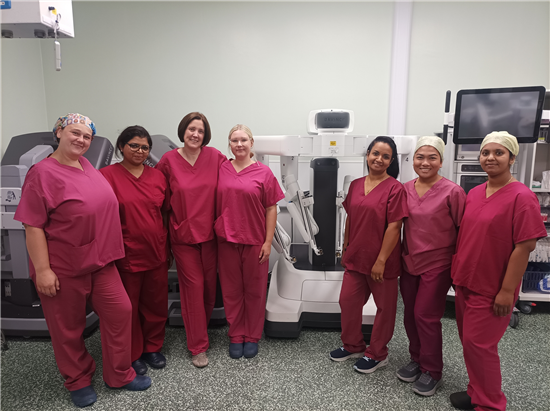UHBW expands robotic surgery with successful first gynaecological operation at St Michael’s Hospital
Last updated: 22/07/2025

Pictured: UHBW surgery team; Nita Paul, Sarah Starr, Claire Newton, Teena Joseph, Samantha Bell, Thahira Puthumana Yousef and Gerdine King
University Hospitals Bristol and Weston NHS Foundation Trust (UHBW) has expanded its robotic-assisted surgery programme, now operating three state-of-the-art surgical robots across the Trust. This advancement was marked by the successful completion of its very first robotic-assisted gynaecological procedure at St Michael’s Hospital (SMH).
The Trust operates two Da Vinci Xi surgical robots - one at the Bristol Royal Infirmary (BRI) and another at SMH, alongside a third robot dedicated to paediatric neurosurgery at the Bristol Royal Hospital for Children (BRHC). This cutting-edge technology is enhancing surgical precision, improving efficiency and supporting better recovery outcomes for patients.
In a major milestone, SMH successfully launched its first robotic gynaecological surgery using the advanced Da Vinci Xi system in June 2025, housed in Theatre 4. The introduction of robotic-assisted procedures in gynaecology marks a significant step forward in delivering high-quality, minimally invasive care.
Over 500 robotic-assisted surgeries have been performed across sites since September 2023, resulting in a collective saving of over 800 bed days, demonstrating the efficiency and recovery benefits of this advanced technology.
Kathy Kantor, 67, from Fishponds, Bristol, was one of the first patients to undergo robotic-assisted surgery at SMH.
Prior to her operation, Kathy experienced a week of postmenopausal bleeding, which resulted in her attending Southmead Hospital for a hysteroscopy - a procedure that uses a thin, camera-equipped tube to examine the inside of the womb. She was soon after diagnosed with endometrial cancer and referred to the specialist clinical pathway at UHBW for treatment.
On 19 June (2025), Kathy underwent a successful robotic-assisted procedure at SMH to remove her womb, cervix, fallopian tubes, sentinel nodes and ovaries.
Reflecting on her experience, Kathy said: "I met the lovely surgeon, Claire Newton, who explained the option of robotic-assisted surgery. It sounded like an excellent choice - more precise, less invasive, and often leading to quicker recovery times, so I said yes immediately.
"The operation took around two hours and I was genuinely surprised at how good I felt coming out of theatre. I only needed to stay one night in hospital, and my recovery has been so much better than I expected.
“I've had much less pain than I anticipated, which has meant that I've been fully mobile from day one. I was initially worried about issues like heavy bleeding or incontinence afterwards, but it’s been a really positive experience from start to finish.
"I can’t thank Claire and the team enough."

Pictured: Kathy Kantor and her husband Béla Kantor
Claire Newton, Consultant Gynaecological Oncologist and Lead for Robotic surgery at UHBW, said: “This investment in robotic surgery is transforming the way we deliver care, enabling our surgical teams to operate with greater precision, shorten recovery times, and ultimately improve outcomes for our patients.
“We’re proud to be expanding the use of cutting-edge technologies like robotic surgery, and we commend our colleagues who have completed their specialist training and are now treating patients using this pioneering approach.
“We have seen a big improvement in patient outcomes following the introduction of robotic surgery at UHBW across all 6 surgical specialties that currently use it. It also helps to reduce musculoskeletal injuries for surgeons, which increases their longevity and improves efficiency.”

Pictured: the Da Vinci Xi surgical robot located at St Michael’s Hospital
The first Da Vinci Xi robot installed in Hey Groves Theatre 4 at the BRI in September (2023) has enabled UHBW surgeons to perform a wide range of procedures, from complex cancer operations to more routine interventions such as tonsillectomies, with greater accuracy and improved patient outcomes.
At BRHC, the paediatric neurosurgery robot officially named Captain Cortex, was introduced in 2024. Manufactured by Renishaw, this pioneering technology supports complex neurosurgical procedures for children across the South West, South of England and South Wales. Captain Cortex is used for approximately 35 procedures a year, supporting the hospital’s Neurosurgery Team to carry out procedures for patients with Epilepsy who are under the Children’s Epilepsy Surgery Service (CESS).
Robotic surgery is a focus of the newly published NHS 10 Year Health Plan (3 July 2025), which positions robotics as a vital tool in advancing healthcare. The plan sets out a bold vision, using robotics to drive precision, revolutionise patient care, and automate services both inside and outside hospital walls. By 2035, NHS England expects robotics to support around half a million operations every year.